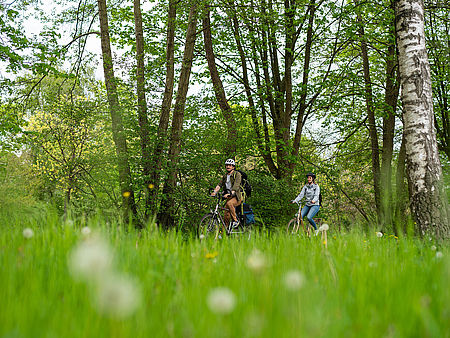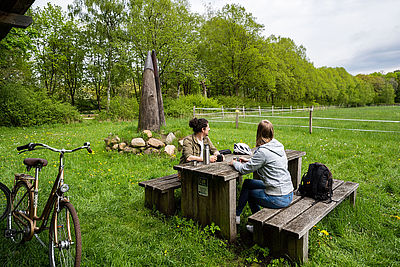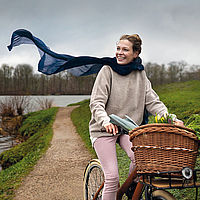
Ox Road
Welcome to the Ochsenweg
The approx. 245-km Ochsenweg (‘Ox Road’) was the central country route between Denmark and North Germany in the 19th century. It was used by farmers as a cattle track but also by knights, soldiers, merchants, pilgrims and beggars as a direct route to the south. Today, cyclists can gain an insight into the nature and cultural history of Northern Germany and Denmark on the historic country route. Away from noisy traffic, the route leads through expansive moors and marshes, through forests and typical northern German meadow and heath landscapes, past lakes and alongside rivers. On the way, you can cycle through attractive cities such as Neumünster and Rendsburg and get to know numerous villages and parishes along the way.

Along the route
Exciting attractions can be found along the way. For example, the Danewerk, a 30-km rampart, is among the oldest archaeological testimonies in Schleswig-Holstein’s history. You can also visit the Rosarium in Uetersen, the Eekholt wildlife park near Bad Bramstedt or the children’s art route KinderKunstpfad in Nortorf. A trip on the historic transporter bridge in Rendsburg is an unforgettable experience, not only for engineering enthusiasts. Gottorf Castle in Schleswig, the Viking Museum Haithabu or the Shipyard Museum in Flensburg present interesting facts on the history of Schleswig-Holstein. At several distinctive junctions (e.g. in Niehuus), huge wooden ox horns were installed, in accordance with the name of the route.
Good to know
Arrival and departure
The cities of Wedel, Elmshorn, Itzehoe, Neumünster, Rendsburg, Schleswig and Flensburg are linked to the Deutsche Bahn railway network. Trains run every hour and can accommodate bicycles.
Route conditions and degree of difficulty
- The route quality in Germany and Denmark is good. The route runs largely along asphalted cycle paths and low-traffic side streets. Up until Rendsburg, you cycle primarily on country roads with concrete slabs. In the north, some sections run along sandy, wooded or field paths. These are the original routes of the historic Ochsenweg.
- In Denmark, some sections have gentle gradients. In Germany, the route is largely flat.
- The cycle route is fully signposted with a logo symbolising the Jutland Peninsula – the landmass between the North Sea and Baltic Sea.
- Due to several sections on unpaved cycle paths and partial sections on busy roads, the Ochsenweg has a medium degree of difficulty. In general, however, it is also suitable for beginners and families with children who can cycle on their own.
Rest stops and overnight accommodation
Restaurants and kiosks are available for meals. Camp and nature sites, hotels, guest houses and youth hostels provide overnight accommodation. There are also classified Bed & Bike facilities along the route.
If you would like to download information about the Ox Road, please click here (in German).
Your contact

Schleswig-Holstein Binnenland Tourismus e.V. c/o RegionNord
Talstraße 9
25524 Itzehoe